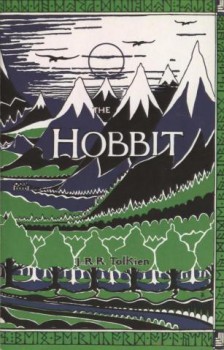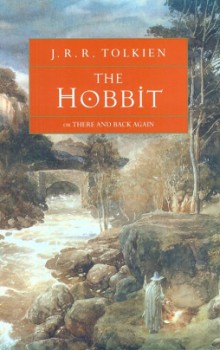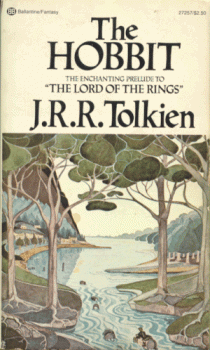Understanding Tolkien: Why His Landscapes Work

There’s no better way to experience the distinction between text and structure than to go back to the roots of our genre.
A few years ago, as a result of a spectacular parenting own-goal, The Hobbit -– a battered old copy that Mrs Harold-Page’s father once purchased for 8s 6d –- ended up as our five year old son’s bedtime story.
It was near midnight, and we were trying to coax our overtired insomniac little boy into sleep mode. I thought, Let’s read something that will hold his attention, but be so far over his head as to hypnotise him into dozing off. Instead, of course, the little blighter perked up and asked enough questions to understand what was going on. The following night — at a more reasonable time — he wanted The Hobbit again. I pointed out it was a bit old for him. Could he even remember the last thing that happened?
They got captured by trolls, but Gandalf did this voice then another voice and the trolls argued until the sun came up and they turned to stone…Is that Smaug on the cover, Daddy?
So, The Hobbit it was.
Reading the Hobbit is a bit like listening to Bill Haley and the Comets. The beat is there, but the delivery — though charming and skilled — is not quite right to the modern taste.
The Hobbit is packed with Herodotian ring composition, editorializing, explicit allusions to the character’s future, and lots of “telling” rather than “showing,” all of which distance us from the story.
Worse, Gandalf is the only person who really does anything until well into the book. It’s page 62 before Thorin even strikes a goblin, and he does that off screen, and in narrative summary — imagine how Robert E Howard would have handled that…
Even so, the story and the world it articulates, rocks.

JRR built a deep history with deeper caverns, and painted the lot with conflict so that we can see it in the light of the Strife Ray (like in CSI where they have a lamp that shows up bloodstains).
And so I’m hooked, and our 5-year-old is hooked, and we’ll both return to this book time and again, just as I’ll listen to Rock Around the Clock when I’m in the mood.
In one matter, however, Tolkien excels over his later imitsuccessors. He knows how to do Landscape Conflict.
Landscapes have to be a key marker for High Fantasy. You know the kind of thing; towering mountains, mystic rivers, ruined cities.
Mostly, I skim this kind of stuff. Odd then that, when I was an early teen, Old Father Tolkien managed to deliver a chunk of real estate direct into my mind’s eye before I could mutter, “If only Conan were age appropriate!” It’s still there.
I’m talking about the approach to the Rivendell and the Misty Mountains – the first three pages of Chapter 3.
Here’s the outline:
The party survived the Trolls and the weather’s better, but the landscape promises danger. The horses graze well, but provisions are low. They ford a river –- a sign of progress –- but mountains loom ahead. They look close, but sinister. Bilbo asks if it’s the Lonely Mountain, but that’s actually a long way away with many dangers before then.
They now risk starvation, but Gandalf pitches the Last Homely House in Rivendell (even now, the name sends a Moomin shiver down my spine –- JRR was a genius). However, “…they had not got there yet.” Almost featureless landscape makes it hard to find Rivendell. They make progress, but find nothing. Worse, the landscape becomes dangerous. The path is marked by white stones, but many of them obscured by moss. Gandalf is the guide, but even he has trouble.
The party reaches the brink of starvation. They forge on through the night, but the going gets dangerous. The ground falls away into a steep valley… is this a disaster? No they’ve found Rivendell and its hellishly merry Elvz!
This isn’t just a scenic tour! Look at all those reversals — the buts and howevers — and what causes them. This is Landscape versus Bilbo & Party.
And the focus never wanders. Even where the landscape doesn’t represent a direct threat — “That’s no Lonely Mountain, Bilbo….” — it still gives the feeling of cards being put into play. And, I do imagine this a bit like a game of cards…

Bilbo: I play Pass Significant Landmark.
Landscape: Ha! I play, Epic Quest Ahead.
Bilbo: Oh crap. Hang on… Resting Place.
Landscape: Ha! Lost in Landscape.
Bilbo: Can he do that..? Right. Ancient Highway.
Landscape: Gotcha. Entropy.
Bilbo: Wizard Guide.
Landscape: (Shakes head.) Entropy is permanent. LOL.
Bilbo: Bugger! Grim Determination.
Landscape: Pitfall.
Bilbo: Happy Reversal! My game I think.
Landscape: Pah! I’ll get you next time.
There is, of course, stuff missing. The sequence doesn’t do much other than get the players characters from A to B, and foreshadow Dangers to Come. Though it sets Bilbo up for personal growth, nobody decides anything, nobody changes. It’s Fantasy as Symphony.
But, even as I write, five years after my last reading of the book, I can still see the landscape, all thanks to Tolkein’s grasp of structure.
M Harold Page (www.mharoldpage.com) is a Scottish-based writer and swordsman. His debut novel The Sword is Mightier came out recently. His Foreworld SideQuest, Marshal versus The Assassins is now available on Amazon.
I actually think ‘The Hobbit’ gives a much clearer and more detailed sense of the landscape through which the characters are travelling than LOTR: not just the big set pieces but the sections in between, which could have been just dull in the hands of a less talented writer. I noticed a similar attention to detail in Peake and Lewis. I think it may have been particular to a certain generation, many of whom had a strong awareness of nature (possibly thanks to writers like Hardy and Houseman) but – whatever about Peake – Lewis and Tolkien were also both big walkers.
You may be right about LOTR/Hobbit.
I bounced off Peake, I suspect because – i the section I did read – though Gormenghast provided a matrix for the story, the characters weren’t engaged with its physicality.
The landscapes of Narnia stick in the head, though. It would be interesting to go back and see how he did it.
Both Lewis and Tolkien were also soldiers in WWI. I wonder if that changed the way they saw landscape?
I wouldn’t disagree with most if your analysis. However I think your analogy of the Bill Haley thing goes right to the heart of why Tolkien
has got beyond mere fantasy genre.
The point is he was largely working to his own design with a personal agenda. Much of the stuff since is about reproducing bits of his invention. One is reminded of a singer on a high fat diet because opera singers tend to be big.
The dwarves are comparatively passive and the bulk of the action is driven but Bilbo and Gandalf because that is part of the world. As it happens hobbies look very like rural English and there are a lot of resonances as a result. Yes it is not a fantasist’s book as such- it is simply much more than that. One of my big complaints about the CGI laden films of the Lord of the Rings was they attempted to turn Tolkien into some sort of sci .fi thing. Elrond’s house was .roger Dean new age mess. If you wanted to get it right you should have looked at an English Arts and Crafts manor house. Lutyens as a set designer would have worked. The same is true of the Elephants in the battle scene. LOTS is essentially a potential alternative European alternative (pre-?) history with roots in European folk lore especially northern European. It all has roots and reflects reality.
Once you can establish that sort of depth other issues emerge. In the hobbits you have the small doing great things almost by accident. The little provincial meets epic. Of course it resonants and it is part of human experience. Ordinary people do get caught up in wars and quests.. That is part of the attraction. As a part of that yes a sense of place is important. In fact the landscape is not porn at all it is integral
> In fact the landscape is not porn at all it is integral
Works both ways, I think. You can’t deliver a metric mega-tonne of Fantasy Real Estate into our souls unless it *is* integral. Shorn of emotional impact, it’s just rocks.
That’s a very good point, frchristopher. I always reckoned that if you wanted to be true to ‘The Hobbit’s visual appeal as a film-maker, you’d have to look at contemporary influences on the author – late-victorian art and literature in particular. So – for example – you’d draw on the pre-Raphaelites in your depiction of the elves.
One thing that was largely ignored in the film is that Pippin and Took are essentially more like a pair of feckless regency bucks than simple village boys. By extension, Bilbo is hobbit of some means, the equivalent of an eccentric country squire. Class can be a touchy subject, but ignoring it can mean substituting one set of stereotypes for another that is just as unpalatable. The first time I saw LOTR, I kept seeing corollaries with Australian/New Zealand stereotypes. Aragorn was a swagman, the elves were a bunch of snotty poms, while the goblins seemed to modelled on aborigines/maoris – why else do the Uruk-hai have dreadlocks?
Interesting point about the regency bucks . I wouldn’t quite agree about the squire thing with Bilbo. He is more one of those people with inherited money who potters. There used to be more of them than now. A combination of changing values and death duties have destroyed them by and large. In real life an Englishman of the type is likely to have been the grandson of a successful stockbroker or solicitor or even a businessman. Comfortably off rather than overly rich. They usually lived in old houses often unchanged in 50 years and had a small collection of family silver, which often included fish knives.At the time it was do common as to need almost no explanation. A modern trustafarian is not quite the same. Actually thereare lots of examples in the writings of the early 20th century. Ratty Mole. Badger spring to mind and the characters in Saki ‘s short stories even Bertie Wooster. The last one of my acquaintance died a few years ago.
I like the idea of preraphaelite elves.
For my view of Rivendell Google Blackwell. House on Windermere by the way.
A very good article. I think that a lot of JRRT’s views on the landscape might have come from both his experiences as a walker, and his experiences in the war.
In both situations, the landscape is something that must be dealt with. It is easy to lose the trail, or find yourself on another trail. It turns out that it’s pretty easy for a flooded creek to stop a column of soldiers, too.
Further, all the “but” and “however” stuff is also a big part of all that– of burning daylight and of not knowing where you are, much less if you are going to get to where you need to be in time.